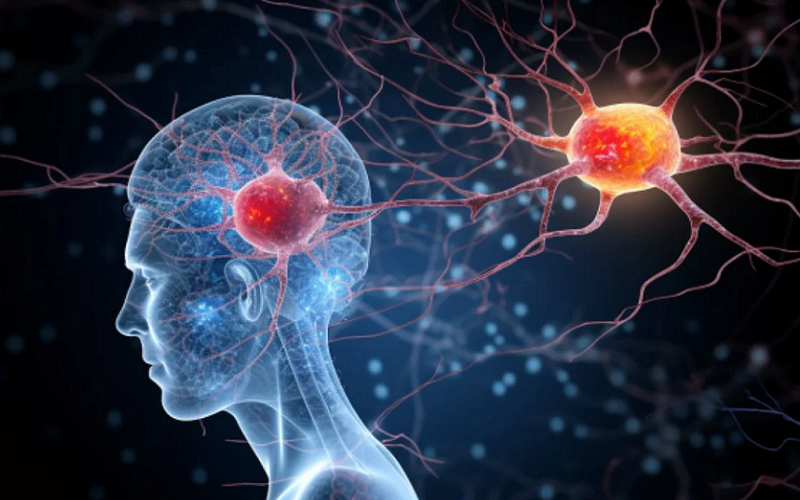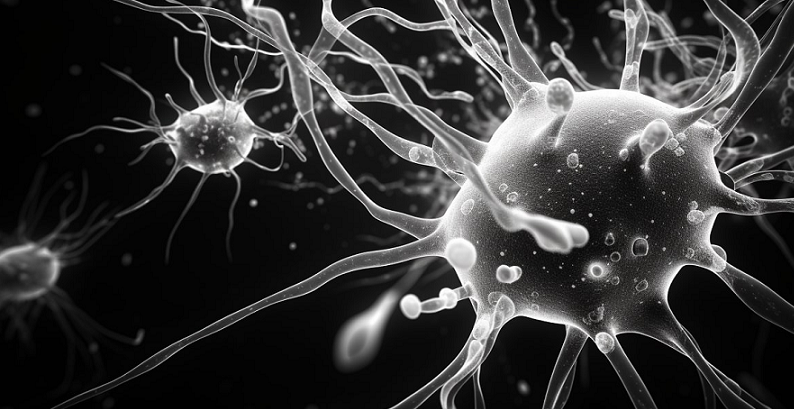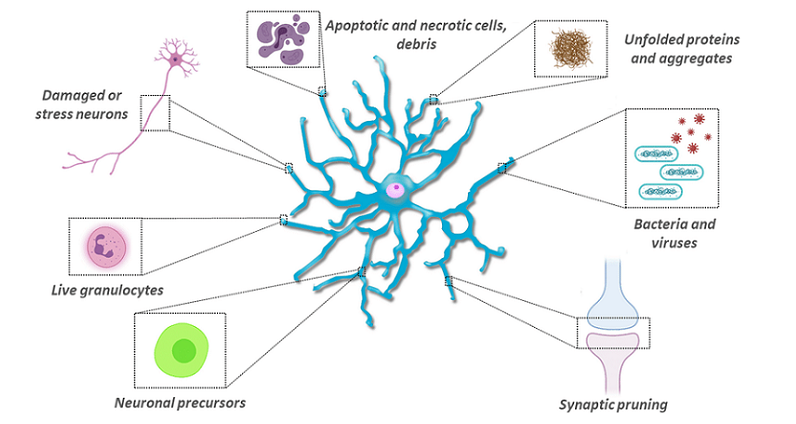
In the intricate tapestry of the human brain, where neurons often steal the spotlight, there lies a lesser-known but equally crucial player: microglia. These tiny yet mighty cells are the unsung heroes, the guardians of our brain’s complex ecosystem. Often overshadowed by their more famous counterparts, microglia play a pivotal role in not just maintaining brain health but also in shaping our cognitive abilities.
Contents
Historical Perspective of Microglia
The journey into the world of microglia takes us back in time, tracing the evolution of our understanding of these unique cells. From their initial discovery to the present day, the history of microglia is as intriguing as their function.
Discovery of Microglia
The story of microglia begins in the early 20th century. It was Spanish neuroscientist Pío del Río-Hortega who, in 1919, first identified and described these cells using a silver carbonate staining technique. This breakthrough was monumental, as it distinguished microglia from other glial cells and neurons, highlighting their unique presence in the brain’s landscape.
Evolution of Understanding of Microglia
Initially, microglia were thought to be mere passive support cells in the brain. However, as research progressed, particularly in the latter half of the 20th century, this perception changed dramatically. Scientists began to recognize the dynamic nature of microglia, understanding their active role in responding to brain injuries and diseases. This shift in perspective marked a significant turning point, leading to more focused research on how these cells contribute to brain health and pathology.
Microglia in the Context of Neuroscience
The importance of microglia in neuroscience has grown exponentially in recent decades. Once overshadowed by neurons and other glial cells, microglia have now emerged as key players in brain development, immune response, and neuroplasticity. This newfound recognition has not only expanded our understanding of brain function but also opened new avenues for treating neurological disorders.

Anatomy and Physiology of Microglia
To fully appreciate the role of microglia as guardians of the brain, it’s essential to examine their anatomy and physiology. These aspects provide the foundation for understanding how microglia function and interact within the brain’s complex environment.
Structural Characteristics of Microglia
Microglia are distinguished by their small size and unique morphology. Unlike neurons and other glial cells, microglia possess a compact cell body from which several thin, branching processes extend. These processes are constantly in motion, surveilling their surroundings. Microglia exhibit remarkable plasticity, changing their shape in response to the brain’s physiological conditions. This ability allows them to efficiently scout for damage, pathogens, or other threats to neuronal health [1].
Functional Roles of Microglia in the Brain
The functional roles of microglia are diverse and crucial. Primarily, they act as the brain’s immune cells, defending against infections and clearing away debris. They also play a vital role in synaptic pruning, a process critical for neural development and plasticity. By eliminating excess or weakened synapses, microglia help optimize neural circuitry. Furthermore, they are involved in modulating inflammation within the brain, a key factor in both normal functioning and in response to injury or disease.
Microglia Activation and Response
In response to brain injuries, infections, or diseases, microglia can transform from a surveillant, or resting state, to an activated state. During activation, they undergo morphological changes, becoming larger and amoeboid. This transformation allows them to effectively engulf and break down damaged cells, pathogens, or harmful substances. This ability to switch between states is crucial for maintaining brain health and responding effectively to various challenges.
Microglia and Brain Health
The significance of microglia extends far beyond their basic anatomical and physiological traits. These cells are integral to maintaining and promoting brain health throughout an individual’s life. By examining their various roles, we can better understand how microglia contribute to overall brain function and well-being.
Microglia Role in Brain Development
During the early stages of brain development, microglia are vital players. They facilitate the formation and refinement of neural networks. This is achieved primarily through the process of synaptic pruning, where microglia help eliminate excess synapses, ensuring efficient and effective neural circuitry. This pruning is crucial for healthy brain development, impacting cognitive functions like learning and memory [2].
Microglia Contribution to Maintenance of Neuronal Health
Microglia also play a continuous role in maintaining neuronal health. They monitor the brain environment and respond to changes that could indicate damage or disease. By removing dead cells and debris, microglia help sustain a clean and healthy environment for neurons to function. Additionally, they release various factors that support neuron survival and promote repair in response to injury.
Microglia Response to Injury and Disease
In cases of brain injury or disease, microglia are among the first responders. They migrate to the site of injury, becoming activated to manage inflammation and start the healing process. Their actions include engulfing and digesting dead cells, fighting off infections, and releasing cytokines that modulate the immune response. This response is crucial for preventing further damage and facilitating recovery. However, an overactive or prolonged microglial response can also contribute to neuroinflammation and neurodegeneration, highlighting the delicate balance these cells must maintain [3].

Microglia in Disease and Disorders
Microglia, while crucial for brain health, can also be involved in various brain diseases and disorders. Their role in these conditions is complex, sometimes contributing to disease progression, and at other times offering potential avenues for therapeutic intervention.
Microglia in Neurodegenerative Diseases
In neurodegenerative diseases like Alzheimer’s and Parkinson’s, microglia play a dual role. On the one hand, they help clear amyloid plaques and other toxic substances that accumulate in these conditions. On the other hand, if over-activated, they can exacerbate inflammation and neuronal damage. The balance of microglial activity is a critical factor in the progression of these diseases. Understanding how to modulate microglial response could lead to new treatments for neurodegenerative disorders.
Microglia Involvement in Mental Health Conditions
Microglia are also implicated in various mental health conditions, including depression and schizophrenia. Recent studies suggest that alterations in microglial function and neuroinflammation may be linked to the pathophysiology of these disorders. For instance, in depression, dysregulated microglial activity could contribute to neuroinflammation and synaptic changes. This emerging field of research holds promise for novel therapeutic strategies targeting microglia [4].
Potential Therapeutic Targets of Microglia
The involvement of microglia in a range of brain diseases makes them attractive targets for therapeutic intervention. Drugs that can modulate microglial activity, either by reducing harmful inflammation or enhancing their protective functions, are being explored. Furthermore, understanding the signaling pathways that control microglial activation and response could open up new avenues for treating various neurological and psychiatric conditions.
The Importance of Microglia in Overall Cognitive Health
The role of microglia extends beyond their immediate actions in the brain. They play a significant role in shaping our overall cognitive health, influencing aspects of learning, memory, and brain resilience throughout our lives. Understanding this role provides a more comprehensive view of how microglia contribute to cognitive wellness.
Microglia Contribution to Cognitive Functions
Microglia are integral to maintaining cognitive functions. Their role in synaptic pruning, especially during early development, sets the foundation for efficient neural networks, essential for learning and memory. In adulthood, their ongoing surveillance and maintenance activities ensure that the neural environment remains conducive to cognitive processing. Emerging research suggests that microglial dysfunction might be linked to cognitive impairments in various neurological conditions, further emphasizing their role in cognitive health [5].
Microglia and Aging
As we age, microglial function changes, which can impact cognitive health. With age, microglia can become more prone to activation and may contribute to increased neuroinflammation, a factor in age-related cognitive decline and diseases like Alzheimer’s. However, maintaining healthy microglial activity through lifestyle choices or potential therapeutic interventions could help preserve cognitive function and delay the onset of age-related cognitive impairments.
Strategies for Supporting Healthy Microglia
Promoting the health of microglia could be a key strategy in preserving and enhancing cognitive health. This could include lifestyle factors like a balanced diet, regular exercise, and adequate sleep, which have been shown to influence microglial health. Additionally, ongoing research into pharmacological agents that can positively modulate microglial activity holds promise for supporting cognitive health, particularly in the context of aging and neurological diseases.
References
[1] Microglia: The protectors of the brain
[2] Microglia in Neurological Diseases: A Road Map to Brain-Disease Dependent-Inflammatory Response
[3] Microglial regional heterogeneity and its role in the brain
[4] What Do Microglia Really Do in Healthy Adult Brain?
[5] Microglia in brain development and regeneration

